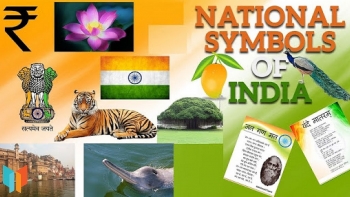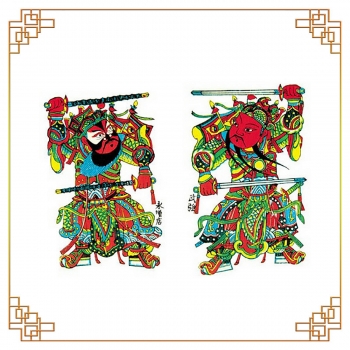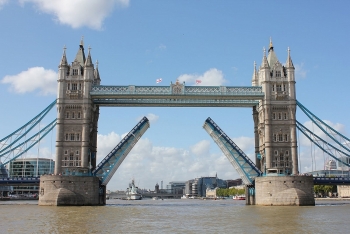Top 9 Iconic Symbols of the Philippines
Here are the top 9 most iconic symbols of Philipines:
#1 National Flag
| Photo: worldatlas.com |
The National Flag of the Philippines (Filipino: Pambansang Watawat ng Pilipinas) is a horizontal flag bicolor with equal bands of royal blue and crimson red, with a white, equilateral triangle at the hoist. In the center of the triangle is a golden-yellow sun with eight primary rays, each representing a Philippine province.
At each vertex of the triangle is a five-pointed, golden-yellow star, each of which representing one of the country's three main island groups—Luzon, Visayas, and Mindanao. The white triangle at the flag represents liberty, equality, and fraternity. A unique feature of this flag is its usage to indicate a state of war if it is displayed with the red side on top, which is effectively achieved by flipping the flag upside-down.
#2 National Anthem
The Philippine national anthem is entitled “Lupang Hinirang” and composed by Julian Felipe. "Lupang Hinirang", or 'Chosen Land'; originally titled in Spanish as the Marcha Nacional Filipina is the national anthem of the Philippines. Its music was composed in 1898 by Julián Felipe, and the lyrics were adapted from the Spanish poem Filipinas, written by José Palma in 1899.
“Lupang Hinirang” was first played publicly on June 12, 1898 during the proclamation of Philippine Independence. Its lyrics were adopted from the Spanish poem, Filipinas, which was written by José Palma.
#3 National Flower
| Photo: wheninmanila.com |
Sampaguita (Arabian jasmine or Sambac jasmine) is a species of jasmine native to tropical Asia, from the Indian subcontinent to Southeast Asia. It is cultivated in many places, especially across much of South and Southeast Asia. It is naturalized in many scattered locales: Mauritius, Madagascar, the Maldives, Christmas Island, Chiapas, Central America, southern Florida, the Bahamas, Cuba, Hispaniola, Jamaica, Puerto Rico, and the Lesser Antilles.
The Philippines adopted the sampaguita (Arabian jasmine, Jasminum sambac) in 1934 as its national flower because it symbolises purity and cleanliness due to its color and sweet smell. It is popularly strung into garlands that are presented to visitors and dignitaries and is a common offering to religious images.
#4 National Tree
| Photo: Pinterest |
The narra tree is a hardy species of indigenous flora. Although it can be found scattered around Asia and Africa, it is particularly respected in the Philippines as the national tree. The tree itself can reach heights of up to 100 feet and carries with it a majestic crown of leaves. Its fragrant odor and durable bark make it a wonderful choice for woodwork projects and cabinetry.
#5 National Language
Filipino, also known as Pilipino, is the national language (Wikang pambansa / Pambansang wika) of the Philippines. Filipino is also designated, along with English, as an official language of the country. Officially, Filipino is defined by the Commission on the Filipino Language (Komisyon sa Wikang Filipino in Filipino or simply KWF) as "the native dialect, spoken and written, in Metro Manila, the National Capital Region, and in other urban centers of the archipelago."
Filipino is officially taken to be a pluricentric language, as it is further enriched and developed by the other existing Philippine languages according to the mandate of the 1987 Constitution. Indeed, there have been observed "emerging varieties of Filipino which deviate from the grammatical properties of Tagalog" in Cebu, Davao City, and Iloilo which together with Metro Manila form the four largest metropolitan areas in the Philippines.
#6 National Bird
| Photo: theculturetrip.com |
The endangered Philippine eagle is a majestic bird of prey that has powerful talons, a 7-foot wingspan, and blue-grey eyes. Mostly solitary and territorial by nature, the Philippine eagle needs thousands of hectares of forest land in order to thrive. They can live up to 40 years in captivity and only lay eggs every two years or so, only after the first of their offspring has gone off on its ow.
#7 National Gem
| Photo: primer.com.ph |
The Philippine national gem is called “Philippine Pearl” as declared by Former President Fidel V. Ramos through Proclamation No.905 s. 1996. It is scientifically known as Pinctada Maxima. There are two different color varieties: the Silver-lipped oyster and the Gold-lipped oyster. These bivalves are the largest pearl oysters in the world. They have a very strong inner shell layer composed of nacre, also known as "mother of pearl" and are important to the cultured pearl industry as they are cultivated to produce South Sea pearls In fact, the world’s largest pearl was discovered by a Filipino diver in a giant Tridacna (mollusk) under the Palawan Sea in 1934.
#8 National sign language
Filipino Sign Language (FSL) or Philippine Sign Language (Filipino: Wikang pasenyas ng mga Pilipino), is a sign language originating in the Philippines. Like other sign languages, FSL is a unique language with its own grammar, syntax, and morphology; it is neither based on nor resembles Filipino or English. Some researchers consider the indigenous signs of FSL to be at risk of being lost due to the increasing influence of foreign sign languages such as ASL.
The Republic Act 11106 or The Filipino Sign Language Act, effective November 27, 2018, declared FSL as the national sign language of the Filipino Deaf.
#9 National Sport
| Photo: theculturetrip.com |
Arnis is to the Philippines like Japan’s Karate and Korea’s Taekwondo. It’s both a martial art and a sport whose origins are still largely unconfirmed because of lack of documentation. It’s known by two other names: Kali and Eskrima, the three are roughly interchangeable umbrella terms for the traditional martial arts of the Philippines ("Filipino Martial Arts", or FMA).
Arnis also includes hand-to-hand combat, joint locks, grappling, and weapon disarming techniques. Although in general, the emphasis is put on weapons for these arts, some systems put empty hands as the primary focus and some old school systems do not teach weapons at all. It became a national symbol in 2009 when then-Pres. Gloria Macapagal-Arroyo signed Republic Act 9850 into law.
Follow KnowInsider for more informative articles!
 Top 9 Most Iconic Symbols of India Top 9 Most Iconic Symbols of India The Republic of India has several national symbols. The national symbols of India represent the culture and nature of India's National Identity. They infuse a ... |
 Top 9 Iconic Symbols of China Top 9 Iconic Symbols of China When mentioning China, what comes to mind? As a country with a history of more than 5,000 years, China is rich in civilization and culture. ... |
 Top 9 iconic symbols of the UK Top 9 iconic symbols of the UK A country is known for its national symbols as representative of that country towards tourists. When it comes to iconic symbols, those things will be ... |


























